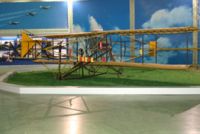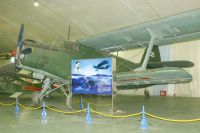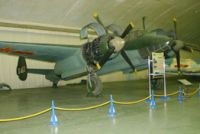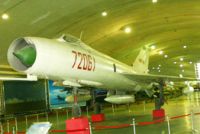China Aviation Museum
The China Aviation Museum is about 40 miles north of Beijing and located at the foot of the fascinating Xiao Tang Hill (Xiaotangshan) in the Changping District of Beijing. It was opened to the public on Nov. 11, 1989.
The museum contains 299 airplanes spanning 120 models and 2,468 weapon samples, including ground-air missiles, high cannons, radar, aviation bombs and aviation cameras.
After World War II, the Chinese air force mainly utilized Russian-built aircraft, such as the MIG-15, MIG-17 and Tupolev TU-4. However, China soon started to develop its own aviation industry. The first Chinese-built attack aircraft was called "A-1." The BT-5 is a Chinese-built trainer version of the Il-28 bomber.
The museum has three parts. First is the tunnel of which both entrances are guarded by an F-7, the Chinese MIG-21. More than 50 aircraft are parked inside the tunnel in two rows. Taking photographs at this location may prove to be difficult, as it is rather dark. At one side, there are a number of aircraft from WWII, including both Chinese and captured Japanese aircraft. They are followed by a number of aircraft from the proceeding era, such as the MIG-15 and MIG-17, and their Chinese alternatives: the F-2, F-5, some F-6s, F-7s and an F-8. Five MIG-15s from the Korean War, from the air force of North Korea, are also on display.
Further on, there are four A-5 "Fantan" attack aircraft and three beautiful B-5s (the Chinese Il-28), a standard B-5, a BT-5 trainer and a BR-5R reconnaissance aircraft. At the end of the tunnel, there are some aircraft from abroad, including a Saber from the air force of Pakistan, a US Army UH-1H that was captured in Vietnam and the latest acquisition of the museum: an F-104S from the Italian air force. This star fighter, coded 4-1/MM6795, was flown to China by an Italian Hercules and handed over by the Italian ambassador to the museum in May 2001. Finally, there is an Apache helicopter, but a closer look will reveal that it is just a full-scale mock up, made by a Chinese colonel in his spare time.
The second part of the museum is a "flight line" of nineteen fighters parked on the taxiway outside. No ropes, fences or information boards make this display of aircraft a perfect chance for some photographs. One of the aircraft is a MIG-15 from North Korea, while the others are from the Chinese air force. They include four FT-2s, the trainer version of the MIG-15; one FT-6, the trainer version of the MIG-19; and thirteen F-5s, the Chinese MIG-17.
The third part of the museum consists of the aprons, grass and corners of the airfield, and it even has a small lake. Here, large aircraft and helicopters can be found, together with even more fighters. The exhibits include two giant TU-4s, the Russian version of the B-29 bomber, in Chinese colors; a TU-16 bomber, a model still active in the Chinese forces; four Russian-built C-47 Dakotas of the Chinese air force; and the only Viscount airliner in Chinese possession.
The museum also exhibits an airplane produced by Feng Ru, China's first airplane designer and producer in the early 20th century.
Further Information: Address: Mail Box No. 5806, Beijing. Open: 8:30 - 17:00 (closed on Mondays) Admission: 50 yuan Tel: 86-10-6178 4882; 86-10-6691 6919



